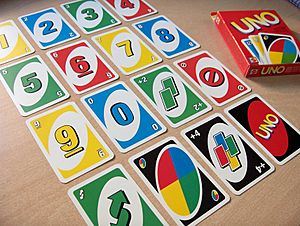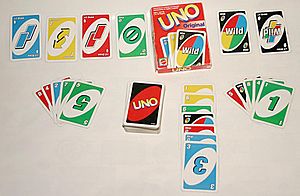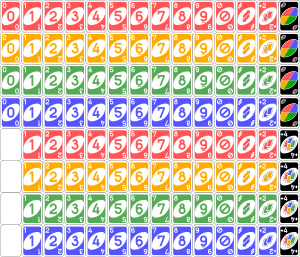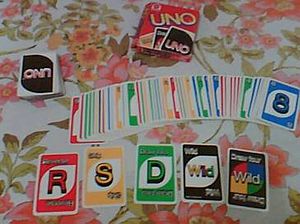Uno (card game) facts for kids
 |
|
| Designer | Merle Robbins |
|---|---|
| Publisher |
|
| Type | Shedding-type |
| Players | 2–10 players |
| Skills required | Hand management |
| Age range | 7+ |
| Cards | 112 |
| Playing time | Varies |
| Random chance | High |
Uno ( from Italian and Spanish for 'one'; stylized as UNO) is an American shedding-type card game that is played with a specially printed deck. The game's general principles put it into the Crazy Eights family of card games, and it is similar to the traditional European game Mau-Mau.
It has been a Mattel brand since 1992.
Contents
History
The game was originally developed in 1971 by Merle Robbins in Reading, Ohio, a suburb of Cincinnati. When his family and friends began to play more and more, he spent $8,000 to have 5,000 copies of the game made. He sold it from his barbershop at first, and local businesses began to sell it as well. Robbins later sold the rights to UNO to a group of friends headed by Robert Tezak, a funeral parlor owner in Joliet, Illinois, for $50,000 plus royalties of 10 cents per game. Tezak formed International Games, Inc., to market UNO, with offices behind his funeral parlor. The games were produced by Lewis Saltzman of Saltzman Printers in Maywood, Illinois.
In 1992, International Games became part of the Mattel family of companies.
Official rules
The aim of the game is to be the first player to score 500 points, achieved (usually over several rounds of play) by being the first to play all of one's own cards and scoring points for the cards still held by the other players.
The deck consists of 108 cards: four each of "Wild" and "Wild Draw Four," and 25 each of four different colors (red, yellow, green, blue). Each color consists of one zero, two each of 1 through 9, and two each of "Skip," "Draw Two," and "Reverse." These last three types are known as "action cards."
To start a hand, seven cards are dealt to each player, and the top card of the remaining deck is flipped over and set aside to begin the discard pile. The player to the dealer's left plays first unless the first card on the discard pile is an action or Wild card (see below). On a player's turn, they must do one of the following:
- play one card matching the discard in color, number, or symbol
- play a Wild card, or a playable Wild Draw Four card (see restriction below)
- draw the top card from the deck, then play it if possible
Cards are played by laying them face-up on top of the discard pile. Play proceeds clockwise around the table.
Action or Wild cards have the following effects:
| Card | Effect when played from hand | Effect as first discard |
|---|---|---|
| Skip | Next player in sequence misses a turn | Player to dealer's left misses a turn |
| Reverse | Order of play switches directions (clockwise to counterclockwise, or vice versa) | Dealer plays first; play proceeds counterclockwise |
| Draw Two (+2) | Next player in sequence draws two cards and misses a turn | Player to dealer's left draws two cards and misses a turn |
| Wild | Player declares the next color to be matched (may be used on any turn even if the player has matching color; current color may be chosen as the next to be matched) | Player to dealer's left declares the first color to be matched and plays a card in it |
| Wild Draw Four/Draw Four Wild (+4 and wild) | Player declares the next color to be matched; next player in sequence draws four cards and misses a turn. May be legally played only if the player has no cards of the current color (see Penalties). | Return card to the deck, shuffle, flip top card to start discard pile |
- A player who draws from the deck must either play or keep that card and may play no other card from their hand on that turn.
- A player may play a Wild card at any time, even if that player has other playable cards.
- A player may play a Wild Draw Four card only if that player has no cards matching the current color. The player may have cards of a different color matching the current number or symbol or a Wild card and still play the Wild Draw Four card. A player who plays a Wild Draw Four may be challenged by the next player in sequence (see Penalties) to prove that their hand meets this condition.
- If the entire deck is used during play, the top discard is set aside and the rest of the pile is shuffled to create a new deck. Play then proceeds normally.
- It is illegal to trade cards of any sort with another player.
A player who plays their next-to-last-card must call "Uno" as a warning to the other players.
The first player to get rid of their last card ("going out") wins the hand and scores points for the cards held by the other players. Number cards count their face value, all action cards count 20, and Wild and Wild Draw Four cards count 50. If a Draw Two or Wild Draw Four card is played to go out, the next player in the sequence must draw the appropriate number of cards before the score is tallied.
The first player to score 500 points wins the game.
Penalties
- If a player does not call "Uno" after laying down their next-to-last card and is caught before the next player in sequence takes a turn (i.e., plays a card from their hand, draws from the deck, or touches the discard pile), they must draw two cards as a penalty. If the player is not caught in time (subject to interpretation) or remembers to call "Uno" before being caught, they suffer no penalty.
- If a player plays a Wild Draw Four card, the following player can challenge its use. The player who used the Wild Draw Four must privately show their hand to the challenging player, in order to demonstrate that they had no matching colored cards. If the challenge is correct, then the challenged player draws four cards instead. If the challenge is wrong, then the challenger must draw six cards; the four cards they were already required to draw plus two more cards.
Two-player game
In a two-player game, the Reverse card acts like a Skip card; when played, the other player misses a turn.
House rules
The following house rules are suggested in the Uno instructions to alter the game:
- Progressive or Stacking Uno: If a draw card is played, and the next player in turn order has a card with the same symbol, that player can play that card and "stack" the penalty, which adds to the current penalty and passes it to the next player (although a +4 cannot be stacked on a +2, or vice versa). This house rule is so commonly used that there was widespread Twitter surprise in 2019 when Mattel stated that stacking was not part of the standard rules of Uno.
- Seven-O: Every time a "7" is played, whoever played it must swap hands with another player of their choice before ending their turn. Every time a "0" is played, all players pass their hands to the next player in the current direction of play, after which play continues normally.
- Jump-In: If a player has exactly the same card (both number and color) as the top card of the discard pile, they may play it immediately, even if it is not their turn. Play then continues as if that player had just taken their turn.
- 6-Smackdown: When a "6" is played, players must place their hand on top of the card, whoever is the last player to place their hand on the card will have to draw 2 cards.
- Keep-Drawing: When it's a player's turn and they don't have a card in their hand that they can play, the player will have to draw until they find a playable card.
2018 rule changes
The two new types of Wild cards have the following functions:
- Wild Shuffle Hands: The player using this card collects all cards held by all players, then shuffles and re-deals them, starting from the player to their left.
- Wild Customizable: There are three copies of this; these cards are blank and can have a house rule assigned to them.
Each of these cards can be played on any turn and is worth 40 points when a player goes out.
2022 rule changes
The goal to reach a certain number of points has been demoted and replaced with the one commonly used by most players, which is to be the first player to go out. If played for points, all Wild cards are again worth 50 points apiece. In addition, if the first card flipped at the start of a game is an Action or Wild card, it is ignored and another card is flipped until a number card comes up.
Strategies
A strategy at Uno may be offensive (aiming to go out), or defensive (aiming to minimize the value of one's hand, in the event that another player goes out, thus getting those points). Part of the skill of playing Uno is knowing when to adopt an offensive or defensive strategy.
An offensive strategy would be holding on to Wild and Wild Draw Four cards because they can be played near the end of the hand in order to go out (when it's harder to play a matching card). However, a defensive strategy would advise getting rid of such cards early, because they have a high point value.
A defensive strategy would advise playing a high card in order to reduce the point value of the hand. However, an offensive strategy would suggest playing a 0 when the player wants to continue on the current color, because it is less likely to be matched by another 0 of a different color (there is only one 0 of each color, but two of each 1–9).
A player holding only one card is required to call out "Uno" or risk being penalized if caught. A player who calls "Uno" risks being the target of concerted action by the other players, who may be able to use action cards to prevent that player from going out. Depending on the level and seriousness of play, some players may deliberately avoid saying "Uno", in the hope of avoiding detection and then going out on the next turn. For this reason, it is useful to conceal how many cards are in one's own hand and to keep track of how many cards every other player holds.
Little has been published on the optimal strategy for the game of Uno. Simulations of games may shed some light on the matter. Attempts to reduce point count in a player's hands can be "read" by other players if too transparent. This information can be exploited by other players, and it follows that a mixed strategy may be more appropriate.
Card and deck styles
Modern Uno action cards bear symbols which denote their action, except for the Wild cards which still bear the word "Wild". Before the design change, such cards in English versions of the game had letters only. Earlier English versions can be recognized by the absence of the white rim that surrounds the edge of most Uno cards.
Other versions of the game use symbols and images in both old and new designs, especially ones with Wild cards that do not bear the word "Wild". There are also language-free versions of the newer styles that do not bear the word "Wild" but have the same styling.
The 2010 "Uno Mod" edition uses symbols instead of letters or numbers.
On September 16, 2017, Mattel released Uno ColorAdd, which was designed specifically for those suffering from color blindness.
On October 1, 2019, Mattel released a Braille version of their game with Mark Riccobono, president of the National Federation of the Blind. Riccobono said in a press release, "The fact that a blind person is now able to play a classic game of UNO straight out of the box with both blind and sighted friends or family members is a truly meaningful moment for our community."
Special Uno games
- Uno 50th Anniversary (2021)
- Uno Wild Twists (2022)
- Uno All Wild (2022)
- Uno Attack (Uno Extreme in the UK and Canada) (1999)
- Uno Attack Jurassic World (2018)
- Uno Attack Refill Deck (2005)
- Uno Bingo (1997)
- Uno Blast (2012)
- Uno Blitzo (2000)
- Uno Choo-Choo (2011)
- Uno Color Screen
- Uno Deluxe (2022)
- Uno Dare (2014)
- Uno Dice (1987, 1996, 2011)
- Uno Dominoes (1986)
- Uno Emoji (2016)
- Electronic Uno (2020)
- Uno Flash (2007)
- Uno Flex! (2023)
- Uno Flip (2009) (Target Store Exclusive)
- Uno Flip! (2019)
- Get Wild for Uno (2016)
- Giant Uno (2016)
- Giant BTS Uno (2020)
- Uno Go! (2022)
- Uno H2O (2004)
- Uno H2O To Go
- Uno Harry Potter (2019)
- Uno Hearts (1994)
- Uno Junior (1992)
- King Size Uno (1994)
- Uno Lightyear (2021)
- Uno Madness (1995)
- Uno Minecraft (2018)
- Uno Moo (2008, 2014)
- Uno Show 'Em No Mercy (2023)
- Uno Party! (2022)
- Uno Power Grab (2012)
- Uno Remix (2022)
- Uno Reflex (2010)
- Uno Roboto (2010)
- Uno Royal Revenge (2014)
- Uno Rummy Up (1993)
- Uno Showdown Supercharged (2020)
- Uno Spin (2005)
- Uno Spin Hannah Montana (2005)
- Uno Spin One Piece (Japan)
- Uno Spin To Go (2010)
- Uno Stacko (1994)
- Travel Uno Stacko
- Uno Tippo (2009)
- Uno Tiki Twist (2014)
- Uno Triple Play (2021)
- Uno Wild Jackpot (2016)
- Uno Wild Tiles (1982)
Uno H2O
Uno H2O differs from the standard game in that the cards are transparent and waterproof. Play is identical to the standard pre-2018 Uno game, with the addition of two types of "Wild Downpour" cards. When one of these is played, all other players must draw either one or two cards as indicated on the card. The player using it may then declare the next color to be matched.
Video games
- Uno (handheld video game) – 2000
- Uno (handheld video game for the Game Boy Color of the classic Uno board game)
- Uno DX (Japanese exclusive Sega Saturn game by Mitsui & Co. – 1998)
- Uno (PlayStation Network)
- Uno (Xbox Live Arcade)
- Uno Rush (Xbox Live Arcade)
- Uno Challenge (mobile version of the classic Uno board game)
- Uno Free Fall (puzzle game for mobile phones)
- Uno 52 (Game Boy Advance)
- Super Uno (Super Famicom)
- Uno (Facebook) (Adobe Flash–based version of the classic Uno card game produced by GameHouse)
- Uno (iPhone) Features online and local play. Produced by Gameloft
- Uno (iPad) The same as on the iPhone, but with enhanced graphics. Produced by Gameloft
- Uno (Android) Released as three versions: SD, HD and Free with adverts. Produced by Gameloft
- Uno (DSi)
- Uno (WiiWare) Produced by Gameloft
- Uno & Friends (various platforms)
- Pocket Uno
- Uno and Uno & Friends for Windows Phone
- Uno Undercover (Windows)
- Uno (2016 video game for PC, PlayStation 4 and Xbox One by Ubisoft)
- Uno (2017) – the 2016 game release on the Nintendo Switch), produced by Ubisoft
Variations
Many variations from standard gameplay exist, such as Elimination Uno, Speed Uno and Pirate Uno.
On February 13, 2018, Mattel released a spin-off of Uno entitled Dos; the game is differentiated primarily by having a "center row" of discard piles, where pairs of cards that add up to the sum of a card on the top of one of the piles may be discarded.
The game can be played with two decks of standard playing cards, if the jokers are marked up as the zeroes of the four suits, and the royalty treated as the special cards.
Spin-offs
Slot machines
In 2002, International Gaming Technology introduced a "pod concept" for grouping the prize winnings of similarly-themed and newly-released MegaJackpot games into one collective pool. Among these was the new Famous Games pod, unveiling two new Mattel-licensed machines, UNO Slots and Magic 8 Ball slots. In the following two years, additional properties were tied into the pod, along with the Video Slot versions of both UNO and Magic 8 Ball.
The UNO slot machine featured a basic vertical 3 wheel system, along with 3 additional horizontal wheels that would activate when 3 UNO bonus symbols in any position were landed with the maximum bet wagered. Meanwhile, the UNO Video Slot Machine featured a 5 reel, 15 line Video system with additional UNO Attack and UNO Triple bonus games awarded based on the symbols landed. Both versions saw limited releases to various Native American gaming centers.
Uno: The Game Show
In March 2013, it was announced that Mattel and the Gurin Company were teaming up to create a game show based on the card game, produced as a half-hour daily strip with a $100,000 cash jackpot along with a primetime version in which contestants competed for 1 million dollars. However, the idea was scrapped later on.
Film adaptation
On February 4, 2021, an action heist comedy film based on the game was announced to be in development for Mattel Films with Lil Yachty of record label Quality Control Music developing and being eyed for the lead role alongside the label's managers Kevin "Coach K" Lee and Pierre "P" Thomas, and Brian Sher for Quality Films producing, Marcy Kelly writing, and Robbie Brenner and Kevin McKeon leading the project as executive producer and supervising producer, respectively.
See also
 In Spanish: Uno (juego) para niños
In Spanish: Uno (juego) para niños





